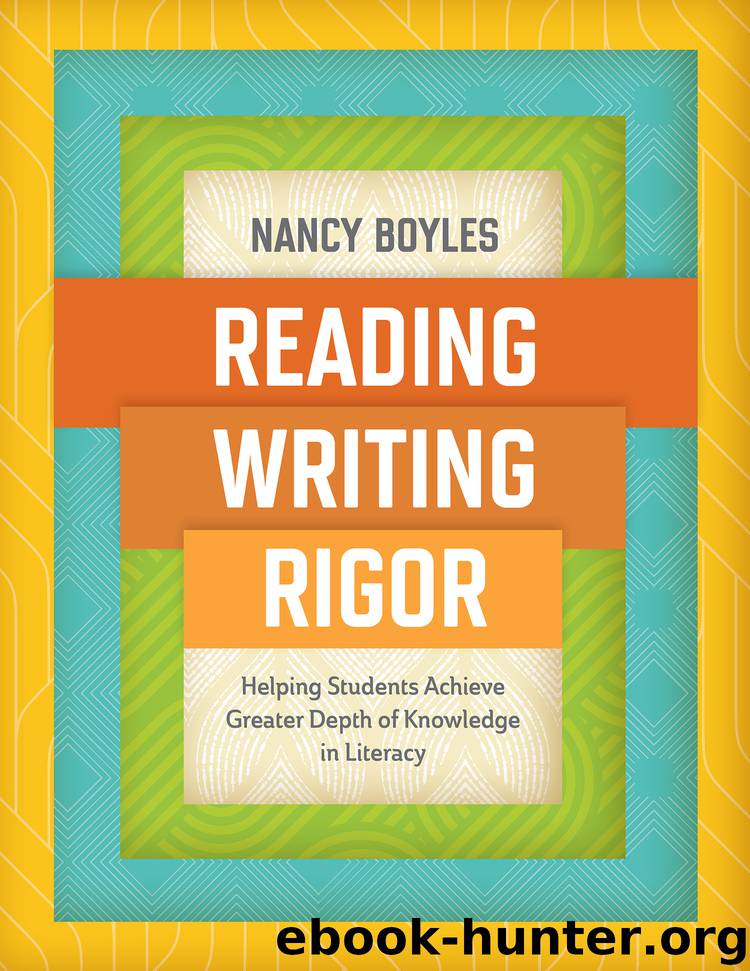Reading, Writing, and Rigor by Nancy Boyles

Author:Nancy Boyles
Language: eng
Format: epub
ISBN: 9781416623434
Publisher: ASCD
Published: 2018-03-31T16:00:00+00:00
What kinds of tasks lend themselves to the rigor of creative thinking? Let's look at what new standards-based assessments are asking students to do to demonstrate their capacity to synthesize information from multiple sources or points of view.
Measuring DOK 4 on Standards-Based Assessments
DOK 4 items almost always involve both reading and writing and are frequently regarded as performance-based tasks. They may differ considerably from state to state. When states move away from the two consortium-based Common Core assessments—the tests designed by the Smarter Balanced Assessment Consortium (SBAC) and the Partnership for the Assessment of Readiness for College and Career (PARCC)—they find that this is the part of the test that changes the most. The standards-based questions for reading remain about the same on all assessments, but there can be wide variation on measures of writing, as well as the amount of writing students are asked to do.
Performance tasks are typically a collection of questions. Some of these questions measure reading, often using multiple-choice items that tap students' understanding of the way sources connect to each other. A few questions call for a constructed response. The reading-related questions are generally aligned with DOK 3, although a limited number that call for students to write about their reading are considered DOK 4. An example of a DOK 4 short-answer item is this: Which source would most likely be the most helpful in locating information about _________________?
The second component of the performance task, the feature that calls for the most "extended thinking," is sometimes referred to as the "full write." Here, students are tasked with writing a full essay or story. These are generally untimed but ask for several pages, or the equivalent of several pages if the test is taken online. Issues surrounding technology, such as young children's lack of keyboarding skills and difficulty navigating the screen layout of a test's content, elicit cries of deep concern from teachers everywhere. I feel your pain, but I can't fix it. We need to stay on track here for instructional priorities where our efforts can make a difference. Increased knowledge of the kinds of full-write items students will probably see on new assessments can lead them in the right direction while also helping them to become better writers.
The full-write tasks identified here are similar to items I've retrieved from various assessments. I've changed the exact content of the questions, but the format is the same. All measures involve writing to sources—often two or more. The tasks fall into several categories: narrative, literary analysis, opinion/argument, informative/explanatory, and research.
Download
This site does not store any files on its server. We only index and link to content provided by other sites. Please contact the content providers to delete copyright contents if any and email us, we'll remove relevant links or contents immediately.
| Administration | Assessment |
| Educational Psychology | Experimental Methods |
| History | Language Experience Approach |
| Philosophy & Social Aspects | Reform & Policy |
| Research |
The Art of Coaching Workbook by Elena Aguilar(48021)
Trainspotting by Irvine Welsh(20041)
Twilight of the Idols With the Antichrist and Ecce Homo by Friedrich Nietzsche(17701)
Fangirl by Rainbow Rowell(7825)
Periodization Training for Sports by Tudor Bompa(7322)
Change Your Questions, Change Your Life by Marilee Adams(6632)
This Is How You Lose Her by Junot Diaz(5747)
Grit by Angela Duckworth(4724)
Red Sparrow by Jason Matthews(4653)
Asking the Right Questions: A Guide to Critical Thinking by M. Neil Browne & Stuart M. Keeley(4558)
Paper Towns by Green John(4162)
Room 212 by Kate Stewart(4097)
Ken Follett - World without end by Ken Follett(3967)
The Sports Rules Book by Human Kinetics(3580)
Housekeeping by Marilynne Robinson(3394)
The Motorcycle Diaries by Ernesto Che Guevara(3325)
Introduction to Kinesiology by Shirl J. Hoffman(3297)
Exercise Technique Manual for Resistance Training by National Strength & Conditioning Association(3285)
Double Down (Diary of a Wimpy Kid Book 11) by Jeff Kinney(3264)
